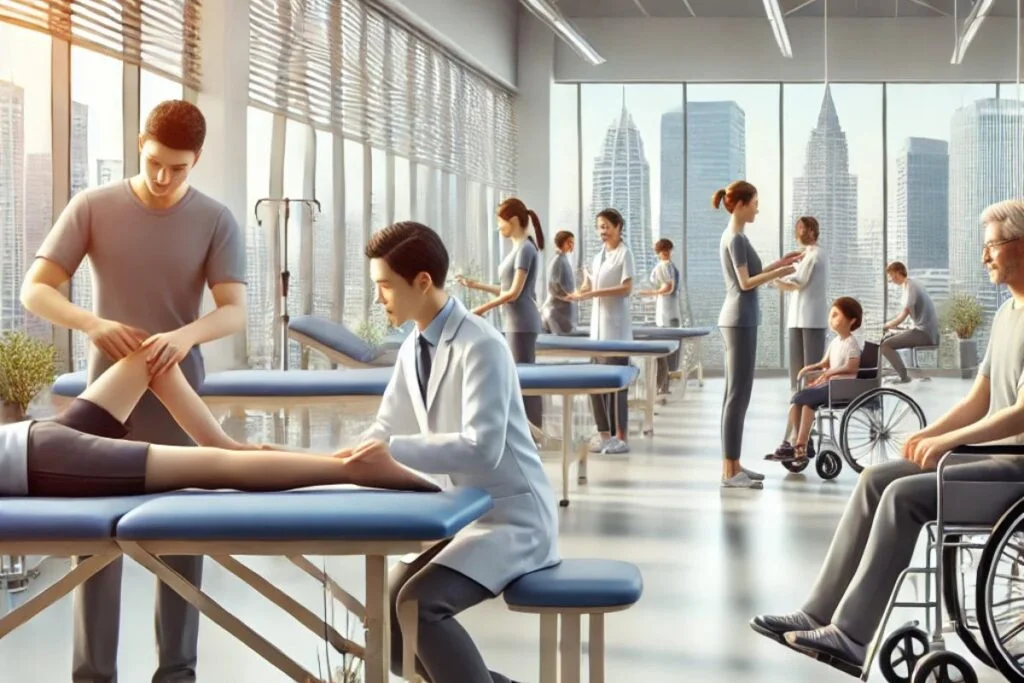
Advance rehabilitation care ,definition, types, and aim
Rehabilitation is a comprehensive process to regain and achieve maximum physical, mental and social functionality after facing injury, illness and disability. It is an evidence based practice based on intervention, perception and goals to improve the quality of life.
Phases of rehabilitation therapy
There are 6 phases of rehabilitation therapy
- Acute phase
- Sub acute phase
- Restoring phase
- Maintenance phase
- Palliative Phase
- Preventative Phase
Acute phase( acute care rehab facility)
In the acute care rehab there is aimed to stabilize the patient and prevent further danger. It is after surgery, injury, or illness onset. This is also known as inpatient rehabilitation
Aims
- Manage pain
- and inflammation
- Prevent further issues or secondary loss like contracture or pressure sore
- Early mobilization Patient positioning on bed
Sub acute phase
Sub acute rehabilitation phase starts with active recovery focusing on functional issues or impairment, improving strength, and mobility. This is also called post acute rehabilitation or outpatient rehabilitation when a patient discharges from hospital.
Aims
Physiotherapy for strength and mobility, Basic functional tasks like gait training daily routine function independency
Gradually improvement in functional improvement under the supervision of expert
Restoring phase
This is maximum independence, functional improvement phase injury or illness. This mostly starts in case post surgery, stroke, and major injuries.
Aims
- Intensive physiotherapy, cognitive or occupational therapy
- Exercises of good strength and endurance building
- Regaining functional tasks and daily activity
Maintenance Phase
Maintain the previous goal and progress to the advance to ensure condition does not worsen or problems do not return. This is outpatient physical rehabilitation phase designed for aged community, chronic diseases and progressive neurological disorders
Aims
- Long term exercise programmed
- Adjusting assistive devices and monitoring therapy plan
- Education of self management techniques
Palliative Phase
Focuses on making a person as comfortable as possible, improving quality of life and managing symptoms of related conditions. This starts with the patients of serious disease like cancer, neurodegenerative disease, end stage organ disease, severe irreversible injury or conditions.
Aims
- Pain management
- Improve function
- Emotional and psychological support
- Support to caregiver
Best rehabilitation center team members
Physiotherapist
Occupational Therapist (OT)
Speech-Language Pathologist (SLP)
Physician
Nurse
Social Worker
Psychologist or Psychiatrist
Dietitian
Prosthetist/Orthotist
Recreational Therapist
Caregiver or Family Member
Goals
- Restore Functions
- Promote Independence
- Symptom Management
- Prevention of Further losses
- Improvement Quality of Life
- Social and Vocational Reintegration
- Holistic Support
Types of rehabilitation therapy
There are different types of rehabilitation programs are explained below
Physical
Improve movements reduce pain and regain or restore pain. In chronic pain, stroke, muscle injuries, arthritis, and post surgery physical rehab work.
Occupational
Occupational rehabilitation enhances ability to perform daily activities and tasks. It works in case of cognitive impairment, stroke, developmental disorder, injuries affecting daily activities.
Speech and Language
Addressing, speech, swallowing, and communication disorders. In cases of
aphasia, dysarthria, stuttering and swallowing issues caused by neurological problems.
Cognitive
Cognitive rehabilitation focuses on cognitive improvement like, memory loss, attention, problem solving and reasoning. It works in cases of brain injuries, stroke and neurological disorders .
Cardiac
Cardiac rehabilitation improve heart function by supervised exercises to change lifestyle and manage stress
Pulmonary
This domain focuses on improving lung function through breathing exercises, ventilations, and oxygen therapy in cases of lung diseases like COPD, asthma.
Neurological
Aims to restore functions and independency in case of neurological conditions.
Pediatric
Helps the children’s developmental abnormalities. It works in the cases of cerebral palsy, autism, and congenital disorders.
Geriatric
Geriatric rehab works in the case of aged people to improve mobility and independence.
Addiction
Addiction rehab provides counseling rehabilitation therapy and medical support to the individual to overcome the substances. Includes detoxification, behavioral therapies, and relapse prevention strategies.
